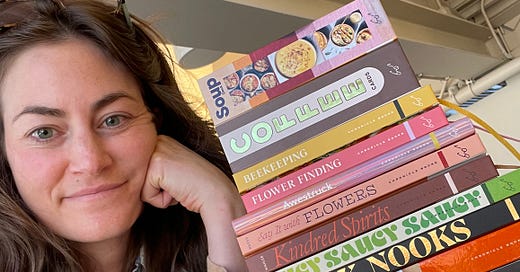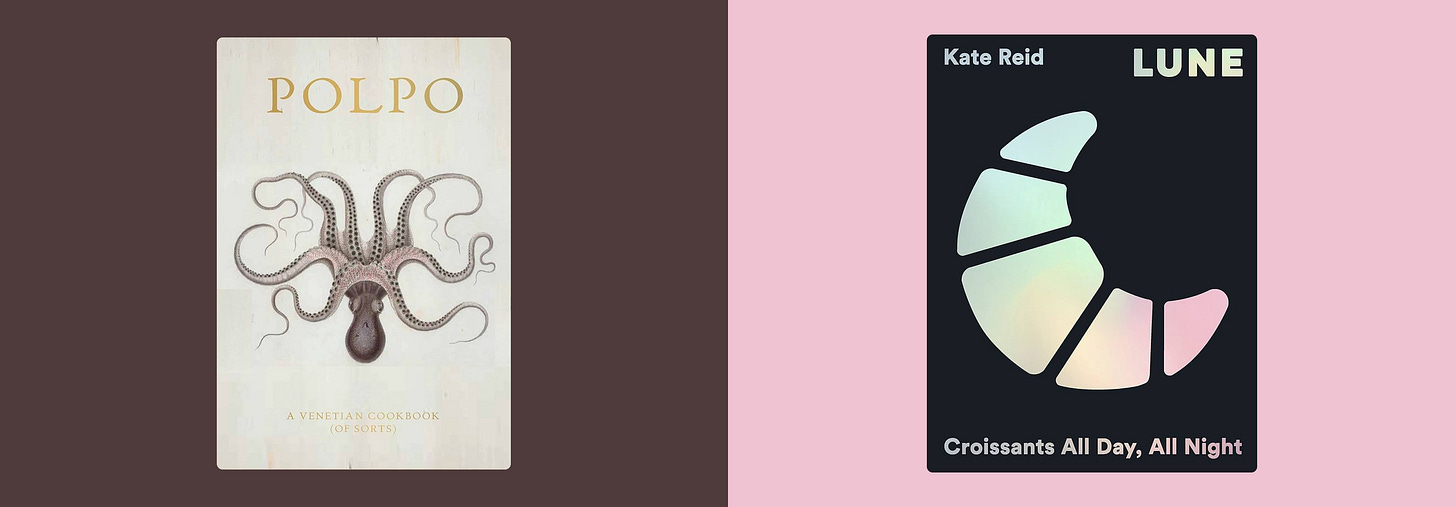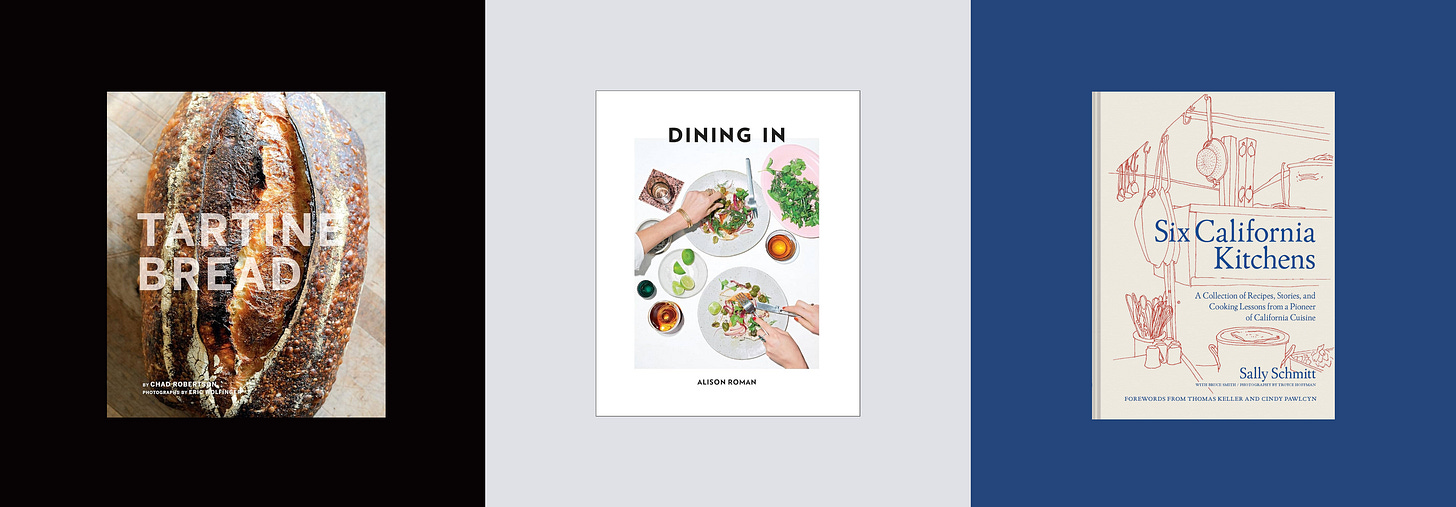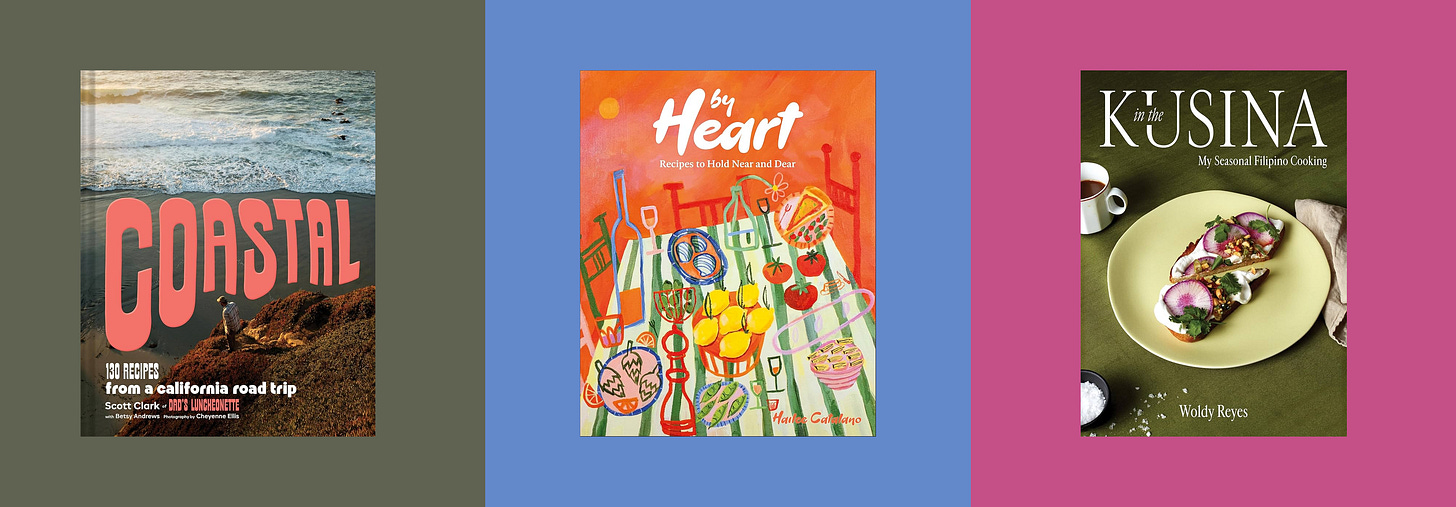No. 15 - The People Really Love Cookbooks with Food and Lifestyle Editor Claire Gilhuly
An interview covering the enduring value of cookbooks, which cookbooks Claire is excited to see on the shelves this year, and which ones she turns to over and over again
This week, I’m delighted to share the first-ever interview on Le Mix, in which I chatted with Claire Gilhuly. Claire and I know each other through a mutual friend (Hi, Dor!!), and once upon a time, the three of us shared a very strange NYU dorm room for a summer spent pursuing wildly different internships in New York. It’s been so fun to see where all of our career paths have gone, and I’m particularly excited to share a bit more about Claire’s path to editing and publishing through this interview!
First, a little more about Claire: Claire is a food and lifestyle editor at Chronicle Books in San Francisco. She edits narrative and single-subject cookbooks, as well as lifestyle books on topics ranging from home decor to parenting to mindfulness. Some of her titles include In the Kusina by Woldy Reyes, Southern Get-Togethers by Kelsey Barnard Clark, Apres All Day by Kelley Epstein, Sweet Pea School by Marryn Mathis, and the Pocket Nature series.
This conversation started as a reason for me to pester Claire with all of my questions about cookbooks, but it really became all about our shared love for cookbooks—why cookbooks aren’t going anywhere, how they shape the way we cook, and what makes them so much more than just collections of recipes. We talk about the joy of getting lost in a single book, the way certain cookbooks mark different stages of life, and the ones we keep coming back to, whether for inspiration or just because they look great on the shelf in our kitchens.
So, whether you’re the kind of person who cooks from your cookbooks frequently or just loves stacking them next to the coffee table, there’s something here for you. Let’s dive in!
MM: To kick things off, why do people love cookbooks so much?
CG: There are a number of reasons people love cookbooks; I think some are more obvious than others. Of course, they’re practical—we all need to eat, and many of us cook to eat. A good cookbook makes that nightly process easier and more enjoyable.
They’re beautiful. Most cookbooks these days are filled with stunning photography and creative design, making them as much a joy to flip through as they are to cook from. Oftentimes, they’re decor objects unto themselves–I’m thinking of books like Polpo or Lune–and they make excellent gifts.
There’s also an element of escapism. Cookbooks take us on a journey, not just through food but through an author’s story, culture, and way of cooking. It’s like traveling without leaving your own kitchen. Von Diaz’s Islas, for example, explores island cooking across the equatorial belt from Puerto Rico to the Philippines and beyond, transporting you to those places via flavors, storytelling, and photography.
And then there’s the sensory experience. In today’s day and age, when we’re all chronically online, cookbooks offer a tangible way to connect with each other and feel grounded in our physical world. The experience of cooking engages all five of our senses–you can see, smell, taste, touch, and even hear the food you’re making (a bubbling soup on the stovetop, the sizzle of garlic). And then you can share that food with family or friends, creating community and connection.
Cookbooks teach, transport, inspire, get food on the table, and bring people together. They’re magic!
MM: Do you think we have reached peak cookbook? Or, to reframe it, what’s driving this passion for cookbooks right now?
CG: I don’t think we’re at peak cookbook. In fact, if you look at the numbers, I think the cookbook market has been pretty stable for a long time. When eBooks, audiobooks, and social media first took off, people worried that physical cookbooks might disappear, but that never happened. Cookbook sales have held pretty steady for the past 15 years. There was a big spike in cookbook sales during the pandemic when everyone was cooking at home more, but things have since leveled out.
Platforms like TikTok and Instagram have definitely played a role in keeping the excitement alive. Watching someone effortlessly throw together a gorgeous dish in a short video makes cooking feel fun and accessible, even for people who didn’t think of themselves as “cooks” before.
There’s also been a renewed appreciation for physical books in general, in part thanks to BookTok. I think people are yearning for more real-life experiences, whether that’s reading a hardcover book, cooking from it, or gathering friends together for a homemade meal.
MM: When you approach a new cookbook as a home cook, do you dedicate yourself to one, or do you jump between multiple books?
CG: In general, I tend to jump around and cook meals based on the ingredients I already have in my pantry or fridge and what I’m in the mood for. If I have a whole bunch of kale I need to use up, for example, I’ll turn to Ruffage by Abra Berens or Tenderheart by Hetty Mckinnon for inspiration.
That said, when I get a brand new cookbook that I’m excited about (usually just a few a year–I try to limit myself now because my collection is getting unreasonable!), I’ll read it in bed like a novel and bookmark a whole bunch of recipes I want to try. Then I’ll spend time cooking my way through them all. I’m deep into Justine Cooks right now, but that doesn’t mean I won’t turn to the New York Times Cooking app for an impromptu dinner, or take a break to bake my favorite bagels from Bagels, Schmears, and a Nice Piece of Fish by Cathy Barrows.
This practice of (sort of) dedicating myself to a cookbook for a spell started with my Cook This Book series, a just-for-fun project where I documented my cooking adventures on social media and on Substack. I found that sticking with a single cookbook for a while helped me get more out of it. It’s like getting to know a person—you learn their style, their tricks, and their philosophy in a deeper way.
MM: Our cooking style is often shaped by our upbringing, culture, and the influences we pick up along the way. Family plays a big role, but cookbooks also shape how we cook—the ingredients we keep on hand, the techniques we lean on, and the flavors we naturally reach for. How do cookbooks influence the way we cook and develop our personal style in the kitchen?
CG: I know plenty of wonderful cooks who didn’t learn to cook from cookbooks and either are self-taught or learned from a family member. But cookbooks are an ideal starting point if you’re looking to develop your skills and style in the kitchen. No matter what you’re trying to learn–how to bake sourdough bread, how to ferment vegetables, how to use masa–there’s undoubtedly a cookbook out there that teaches that very technique.
For me, The Silver Palate Cookbook was the first cookbook to leave an impression. My mom gave it to me when I was about 12, and I remember reading it in bed at night and then cooking a few recipes here and there–mainly easy stuff like muffins and pancakes, but it really inspired me. So much so that later, when I took a gap year before college, I decided to go to cooking school in France.
My love for cookbooks deepened during that period–I was really into Ina Garten and Ruth Reichl at the time–but I didn’t yet see it as a potential career path. It wasn’t until my late twenties that I reconnected with cooking and, after some twists and turns, began working at Chronicle Books on the food and lifestyle editorial team.
All that to say that those cookbooks were formative not only in laying the foundation for my cooking style but also in guiding me towards the career path I’m currently on.
MM: Which cookbooks have pride of place in your home?
CG: My most-used cookbooks live in my kitchen. It’s a rotating cast of characters but Julia Turshen’s Small Victories is always there, as are Hetty McKinnon’s books To Asia with Love and Tenderheart. Julia Turshen is one of my all-time favorite cookbook authors; I think she’s a really talented chef and teacher. Each recipe in Small Victories, for example, builds in little wins, tricks, or teaching moments to help you become a better cook. And Hetty’s recipes are just reliably delicious.
All the cookbooks I’ve edited live in my home office on a bookshelf so I can easily reference them on work calls. And then I have books I’ve cooked from in the past but now mostly display, like Tartine Bread, a total classic with a delightfully puffy case. That one, Alison Roman’s Dining In, and Sally Schmitt’s Six California Kitchens are stacked beneath decorative bowls on the open shelves in our kitchen. I still pull them out sometimes, but I appreciate that cookbooks can serve multiple purposes—both decorative and functional.
MM: On cookbooks reflecting different stages of life:
CG: My husband and I recently visited an art gallery featuring Dave Muller’s work. In addition to lots of other series, he paints commissioned “portraits” of record collections that tell a person’s life story. I love that concept, and I think it applies to books, too, especially cookbooks. If you had to pick five or ten cookbooks that represent phases of your life, what would they be? It’s such an interesting way to think about how our cooking and influences evolve over time.
MM: Which cookbooks are you particularly excited about seeing published this year?
CG: I’m excited about Coastal by Scott Clark–it’s a Chronicle book but not one I edited. (My boss edited it!) It’s a California road trip cookbook with a vibey design and drool-worthy recipes–Perfect Meyer Lemonade, Furikake Popcorn, Dungeness Crab Rice. Scott runs Dad’s Luncheonette in Half Moon Bay, which is not far from where I grew up, so for me, it feels like hometown cooking made fancy.
I’m a longtime fan of Hailee Catalano, and her first cookbook is coming out this year, By Heart. I love an illustrated cover!
One that I worked on that I’m excited about is In the Kusina by Woldy Reyes, coming out in April. It’s a Filipino-American cookbook organized by season. Woldy came up in fashion before becoming a caterer/chef — and he's a lovely, inspiring person (very stylish, too). The book is beautiful with artful photography, and the recipes are innovative yet accessible, focusing on in-season produce.
That's something I always come back to: I like cookbooks that are really usable with recipes that aren't intimidating but that introduce you to new flavors or an unfamiliar technique–cookbooks that broaden your horizons without making cooking feel like a chore. Woldy’s recipes are fresh but not too difficult; he toes that line really well.
Thank you Claire! You can follow her on Substack and keep up with Chronicle’s latest here.
Le Mix is written, edited, and designed by Morgan McCarty. Anything you’d like to see included? Questions? Reply to this email or comment to reach me. And if a friend shared Le Mix with you, click here to subscribe!














that’s such a beautiful interview! really love that across the continents cookbook lovers speak the same language of love for food, travels and beautiful creations !
Such a great interview! I published my first three cookbooks with Chronicle (Sarah Billingsley is my longtime editor) and I love the whole Chronicle crew. It's such a treat to get deeper into the mind of editors like Claire and hear their point of view on the industry, which we don't often get to hear. 🤍